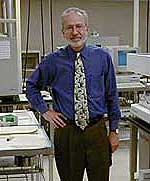By Eugene Cha
Minnesota Public Radio
June 14, 2002
Minnesota is not known as a leading center for biotechnology. But a Minnetonka-based company, and a major effort at the University of Minnesota, may give the state a lead in an emerging area of biotech, where the finished products are not medicines, or even crops, but industrial materials like plastic.
| |
|
|
|
||
In 1989, a young researcher at the agribusiness giant Cargill got his marching orders - find new uses for corn. Pat Gruber had just received his Ph.D. in biological chemistry from the University of Minnesota. He set out to turn corn into plastic. It had been done before, but the plastic that resulted didn't have commercial value.
Gruber knew that if he fermented corn sugars with the right bacteria, and distilled it, he had a chance of making a plastic that would sell. The key turned out to be something you can find at the grocery store.
"You pick up a yogurt container. It says, 'lactobacilli' on the label, 'live culture.' That's the stuff," says Gruber.
He made the first test batches with yogurt bacteria on his kitchen stove, and found it could produce a high quality plastic.
Cargill and its partner, Dow Chemical, have invested $750 million to develop the new product, which they call NatureWorks™.
Gruber says plastic contains the same basic element, carbon, whether it's made from petroleum or from corn.
"One hundred percent of the carbon contained in our product comes from corn. The mass of the corn comes from carbon dioxide in the atmosphere," says Gruber. "Literally, our stuff, six months ago, was in Joe's cornfield somewhere in Nebraska as carbon dioxide."
| |
|
|
|
||
Gruber says NatureWorks™ is made from a renewable resource, requires less energy than petroleum-based plastics, and generates just two-thirds the greenhouse gases.
NatureWorks™ has won several technology awards, including the U.S. Department of Energy's 2001 Technology of the Year Award. Deputy assistant secretary Denise Swink says it's a big improvement over making plastics from oil.
"The bio-based routes are much less energy intensive and obviously use a biofeedstock, in this case, corn," says Swink. "The clear thing is that they have developed a process that is hands-down competitive with petroleum routes to the same products."
NatureWorks™ plastic found customers in Europe and Asia first, where it's used as packaging. This month it'll appear in the U.S., as filling in pillows and comforters.
University of Minnesota officials are trying to make it easier for other companies to repeat Cargill Dow's success, and make Minnesota a leader in an emerging industry. The University has spent $40 million to equip a facility called Biodale, where researchers and companies investigating biotech applications can rent sophisticated scientific equipment.
|
"Literally, our stuff, six months ago, was in Joe's cornfield somewhere in Nebraska as carbon dioxide."
- Cargill researcher Pat Gruber |
Tangles of tubes hang from the ceiling in Biodale's labs. Bob Elde, dean of the University's College of Biological Sciences, says researchers may be able to create other new substances by adapting the basic fermentation process Cargill Dow uses. He says Biodale can help researchers genetically tailor bacteria and other micro-organisms to produce desirable results.
"As new materials come down the road...it's likely that these companies will be able to capture that value and make jobs for more Minnesotans," says Elde.
The opportunity could be huge, according to Heath Lukatch, a US Bancorp Piper Jaffray venture capitalist specializing in biotechnology. Lukatch and consulting firm McKinsey and Company estimate the market for bioengineered industrial materials could reach $470 billion a year by 2010.
Lukatch says consumers may be more willing to accept biotech plastics and materials, than bioengineered drugs or crops.
"When you think about agriculture, you're talking about something that is going into the human body. There is quite a bit of concern there," says Lukatch. "In addition, what you're talking about is genetically modifying plants and animals, and concerns that they will be released ito the environment."
Lukatch says industrial biotech materials also face less regulation than bioengineered drugs.
Lukatch says no region of the country has a dominant lead in industrial biotech. Lukatch says Cargill Dow and the U of M's initiatives give Minnesota a solid start. But he cautions that the real test is whether customers are willing to pay for these new bioengineered products.
More Information

